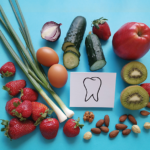 Maintaining good oral health is essential for overall well-being, and your diet plays a significant role in this. Here are some foods that can promote oral health:
Maintaining good oral health is essential for overall well-being, and your diet plays a significant role in this. Here are some foods that can promote oral health:
Water—Staying hydrated is crucial for saliva production, which helps wash away food particles and bacteria in your mouth, reducing the risk of cavities and gum disease.1 Drinking fluoridated water can help strengthen tooth enamel and protect against tooth decay.2
Dairy Products—Dairy products like milk, yogurt, and cheese are rich in calcium and phosphorus, which are essential for strong teeth and bones. Cheese, in particular, can help stimulate saliva production and neutralize acids in the mouth.3,4
Leafy Greens—Vegetables like spinach, kale, and collard greens are high in vitamins and minerals, including calcium and folic acid, which promote healthy teeth and gums.1,5
Crunchy Fruits and Vegetables—Apples, carrots, celery, and cucumbers have a natural crunch that can help clean teeth by removing plaque and stimulating saliva production.1,5
Lean Proteins—Lean meats, poultry, fish, and eggs are rich in phosphorus, which, along with calcium, contributes to strong teeth and enamel.1,6
Nuts and Seeds—Almonds, cashews, and sunflower seeds are good sources of calcium and protein, which are important for maintaining tooth structure. Hazelnuts and pecans are rich in polyphenols, which have been shown to play an important role in maintaining oral health.6,7
Tea (Green or Black)—Tea is also rich in polyphenols, which can inhibit the growth of bacteria in the mouth and reduce the risk of cavities.7,8 Just be mindful of adding sugar or acidic additives.
Sugar-Free Gum—Chewing sugar-free gum, especially one containing xylitol, can stimulate saliva production and help neutralize acids in the mouth.9,10
Cranberries—While cranberries are acidic, they contain phenolic compounds that can help prevent bacteria from sticking to teeth, reducing the risk of cavities. Be cautious with cranberry products that have added sugar. Blueberries are also rich in polyphenols.11
Probiotic Foods—Some probiotic-rich foods like yogurt with live cultures may promote a healthy balance of bacteria in the mouth and reduce the risk of gum disease.12 However, research is still ongoing to determine which strains of bacteria with probiotic activity are most suitable for the mouth.12
Garlic and Onions—These foods contain sulfur compounds that can help reduce the growth of harmful bacteria in the mouth. They can also aid in overall immune system health.13,14
In Summary—Remember that while these foods can contribute to oral health, they should be part of a well-balanced diet and good oral hygiene practices, including regular brushing, flossing, and dental check-ups, should also be maintained to ensure optimal oral health. Additionally, it’s a good idea to consult with a dentist or dental professional for personalized advice on maintaining your oral health through diet.
Sources
- Harvard T.H. Chane School of Public Health website. The nutrition source. Oral health. Dec 2022. https://www.hsph.harvard.edu/nutritionsource/oral-health/. Accessed 27 Sep 2023.
- United States Centers for Disease Control and Prevention website. Community water fluoridation. 15 Jan 2020. https://www.cdc.gov/fluoridation/index.html. Accessed 27 Sep 2023.
- Shkembi B, Huppertz T. Impact of dairy products and plant-based alternatives on dental health: food matrix effects. Nutrients. 2023;15(6):1469.
- Herod EL. The effect of cheese on dental caries: a review of the literature. Aust Dent J. 1991;36(2):120–125.
- University of Illinois Chicago College of Dentistry website. Eat fruits and veggies for a healthy smile. 25 Jul 2017. https://dentistry.uic.edu/news-stories/eat-fruits-and-veggies-for-a-healthy-smile/. Accessed 27 Sep 2023.
- Jayasinghe TN, Harrass S, Erdrich S, et al protein intake and oral health in older adults: a narrative review. Nutrients. 2022;14(21):4478.
- Naureen Z, Medori MC, Dhuli K, et al. Polyphenols and Lactobacillus reuteri in oral health. J Prev Med Hyg. 2022;63(2 Suppl 3):E246–E254. 36479495; PMCID: PMC9710395.
- Harvard T.H. Chan School of Public Health. The nutrition source. Tea. Apr 2023. https://www.hsph.harvard.edu/nutritionsource/food-features/tea/. Accessed 27 Sep 2023.
- Dodds MW. The oral health benefits of chewing gum. J Ir Dent Assoc. 2012;58(5):253–261.
- Janakiram C, Deepan Kumar CV, Joseph J. Xylitol in preventing dental caries: a systematic review and meta-analyses. J Nat Sci Biol Med. 2017;8(1):16–21.
- Oral Health Foundation website. Cranberries and blueberries – why certain fruit extracts could provide the key to fighting tooth decay. 8 Jan 2018. https://www.dentalhealth.org/news/cranberries-and-blueberries-why-certain-fruit-extracts-could-provide-the-key-to-fighting-tooth-decay. Accessed 27 Sep 2023.
- Seminario-Amez M, López-López J, Estrugo-Devesa A, et al. Probiotics and oral health: a systematic review. Med Oral Patol Oral Cir Bucal. 2017;22(3):e282–e288.
- Bakri IM, Douglas CW. Inhibitory effect of garlic extract on oral bacteria. Arch Oral Biol. 2005;50(7):645–651.
- Corzo-Martínez M, Corzo N, Villamiel M. Biological properties of onions and garlic. Trends in Food Science & Technology. 2007;18(12):609–625.





